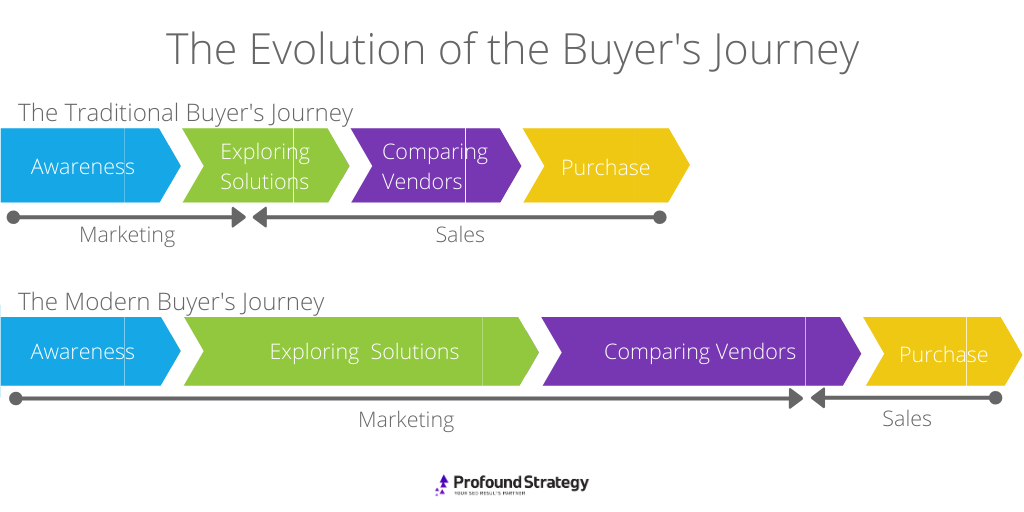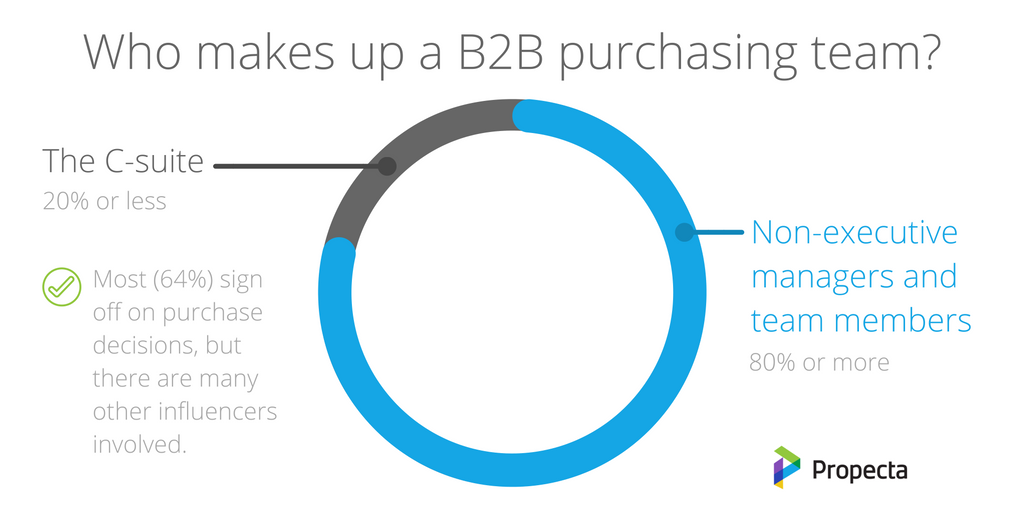The Case for B2B SEO: 4 Reasons It Cannot Be Ignored
B2B buyers aren’t picking up the phone to ask questions about your products and services anymore—they’re heading straight to the nearest screen to find the answers for themselves. Driven by tech-savvy millennials, self-directed buyers not only place value on the online search process, they overwhelmingly prefer it.
- More than 81% of B2B buyers start the purchase cycle with web search.
- Roughly 59% of those say they don’t want to interact with a sales rep until it’s on their own terms.
So, why aren’t more B2B companies putting SEO at the top of the priority list?
By now, most B2B marketers are aware that SEO is a powerful online vehicle, but they may not know how to get started. Others are struggling to get the executive buy-in they need to launch a serious campaign.
Instead, resources are often poured into other digital marketing strategies, such as inbound content, email, video, and social media—without appreciating that SEO can push most of these tools to their highest revenue-earning potential. (Search search drives 300% more traffic to websites than social media alone.)
Get your team, your manager, your C-suite, etc. on board, and start building a B2B SEO strategy that drives real results and impacts your company’s bottom line.
Ready for an update? Check out 7 B2B SEO best practices →
Now is the Time to Invest in SEO for B2B
SEO is not an easy thing to just jump into: search engines and, thus, best-practices are constantly evolving, and most B2B marketers are plenty busy as it is. But the digital market, the growing scale of B2B purchase processes, and the competition all demand that you throw your hat in the ring.
1. SEO Supports Longer, Modern B2B Buying Cycles
The traditional sales funnel model from five to 10 years ago is completely obsolete, even in most B2B verticals:
- 58% of B2B buyers spend more time researching purchases than just three years ago. More than two-thirds of buyers attributed the increase to checking out a greater number of sources, and more actively evaluating and comparing vendors to discover the best ROI.
- B2B buyers conduct an average of 12 searches before they even engage with a website!

Longer buying cycles means B2B customers are asking a lot more questions—and it’s up to brands to ensure that they appear in the search results with the right mix of content to effectively address all of their audience’s needs.
Buyers’ hesitancy to engage with a site or contact sales means that more of the funnel has become marketing tasks. It means SEO, specifically, needs to ensure that the right content is not only available, but available at the right time.
2. The Face of B2B Decision Makers is Changing
B2B companies often focus on senior-level executives, but execs aren’t always the people conducting research. In fact, while 64% of executives give the final sign off, more than 80% of the average purchasing team is below the executive level.

That means department managers, supervisors, ambitious team members, trusted employees, etc. (in addition to executives) are all searching for your solution, and they all have different needs, biases, and degrees of expertise.
Someone in IT, for example, is primarily focused on how well a solution integrates with existing systems, while Sales and Marketing want to know how it affects their particular processes. An executive-level team member wants to see case studies and price charts at a glance, a manager has the time and motivation to dig into a thorough ebook or whitepaper, and an intern or entry-level team member is looking for blog posts and infographics that can explain the basics.
All of your content has the potential to influence a buying decision—if the right people can find it when they need it.
3. Google is Better Than You at Search
Google Is Better Than You: As companies continue to invest in their online capabilities, many B2B firms have incorporated a search bar into their website. An occasional counter-point to SEO recommendations for resources and key landing pages is, “People can find it when they search our website.”
A search bar is a good idea, but Google is the king of search, not your brand site. Don’t count on your audience using it.
First, for a B2B buyer to use your search bar, they have to be able to find your website. Second, internal search functions suck—that’s a fact. They are often clunky and convoluted, and rarely lead to a revenue opportunity. There are lots of ways to fix this, of course, but meanwhile B2B buyers are heading back to Google to find the next vendor.
4. You Are Not Alone in the B2B Online Marketplace
The digital, B2B marketplace is downright crowded. Instead of competitors being hundreds of miles away, they’re setting up shop in the same neighborhood to compete for the exact same business.
The good news is that the competition is still your biggest competition, and it’s still (mostly) a fair fight. 90% of clicks on the first page of Google’s search results are on organic links—not ads or Google’s own content. That means good SEO is the modern equivalent of the biggest, brightest sign or window display.
The bad news is the competition isn’t going away anytime soon. More and more companies are making the time to update their content marketing and SEO strategies, which means the opportunity to get in at the front of the line is shrinking daily.
The Path to B2B SEO: A Checklist
The path to great B2B SEO can often feel like a long, winding road. While SEO certainly takes time and effort, there are a few steps B2B marketers can take to get started on improving their ranking in the search engines right away.
- Understand your brand’s current visibility in web search. Talk to the sales team to find out what questions your customers ask throughout their buying journey, then dig out your top target keywords. Use an SEO tool, like SEOmonitor, to see where the brand currently stands in search engine rankings—especially compared to competitors.
- Evaluate technical limitations. Even Fortune 100 companies often fall short on SEO. Common faults include failing to use meta descriptions, misuse of keywords, and not adjusting SEO page titles for keyword phrases. Take a look at your technical SEO to make sure you’re getting the most out of your efforts.
- Improve User Experience (UX). When it comes to online experiences, digital natives are especially demanding—but they are not alone. Once technical issues are cleaned up, review the site’s entire user experience: Is the navigation intuitive? Does content load quickly? Is there engaging media and/or interactive elements on each page? Pull up the site on a smartphone and tablet as well, and make sure everything is fast and easy to use.
- Create content that answers the most important questions in the buyer’s journey. Once the team has narrowed down a list of top keywords and phrases, create content that addresses those needs. Make sure you have content for various personas at each stage of the buyer’s journey.
At the beginning of the buying cycle, B2B buyers look for quick, digestible information—this can be executed through short blogs, videos or infographics. At the end of the funnel, executives are ready to dive into deep resources—things like long-form blogs, case studies, vendor comparisons, pricing charts, ebooks, and whitepapers.
Whatever mix you decide to use, just make sure it isn’t overly promotional. Today’s sophisticated customers are looking for useful information, not thinly veiled ads.
Business-to-Business SEO is Status Quo
SEO is not a marketing trend: it is quickly becoming the status quo. With B2B buyers now directing the purchasing process, it’s imperative that businesses take a “customer-obsessed” approach to creating an effective SEO strategy or risk getting left behind.
Just remember: the key to great SEO isn’t about manipulating search results, it’s about providing the best possible content for your potential and existing clients. Effective business-to-business SEO provides the path for your customers to discover you.
What's Next?
Profound Strategy is on a mission to help growth-minded marketers turn SEO back into a source of predictable, reliable, scalable business results.
Start winning in organic search and turn SEO into your most efficient marketing channel. Subscribe to updates and join the 6,000+ marketing executives and founders that are changing the way they do SEO:
And dig deeper with some of our best content, such as The CMO’s Guide to Modern SEO, Technical SEO: A Decision Maker’s Guide, and A Modern Framework for SEO Work that Matters.




